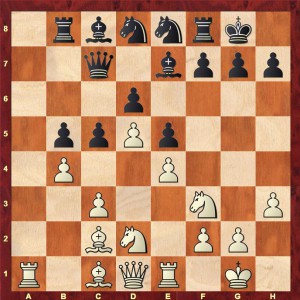Looking through old albums for pictures for the website photo gallery put me into a nostalgic mood. Some games in your career take on almost mythical proportions in your mind. One such game is my game against J Thomson in the 1984 Thanet Major. I was very young – just 10 at the time – and rated around 1660. My opponent was rated a little higher (about 1750)
My games from that period were characterised by efficiency. I played many games against weaker junior opponents which I won by gaining material early on and then swapping off to a winning endgame. This game however was the first game in which I demonstrated the ability to calculate and the desire to sacrifice material in order to finish off a game and I was immensely proud of it at the time. So does it live up to its billing? Well, judge for yourselves!
Thomson – Sadler
Thanet Major 02.09.1984
1.e4 e5 2.Nf3 Nc6 3.Bb5 a6 4.Ba4 Nf6 5.0–0 Be7 6.Re1 b5 7.Bb3 d6 8.c3 0–0 9.h3 Na5 10.Bc2 c5 11.d4 Qc7 12.d5 Nb7 13.Nbd2 Nd8 14.a4 Rb8 15.axb5 axb5 16.b4 Ne8

This manoeuvre is originally attributed to Rubinstein. My coach Steve Giddins had shown me the games that Rubinstein had played against Bogolyubov in 1925 and 1926 in which he had held his own very successfully. Black aims to re-establish some harmony in his development by redeploying the knights to f7 and g7 behind pawns on f6 and g6. Once he has achieved this, then kingside play with …f5 becomes possible. Bogolyubov had preferred to play c4 instead of b4 but had achieved little. b4 is the modern treatment made famous by Karpov in games such as the one against Unzicker in Nice 1974:
16…Nb7 17.Nf1 Bd7 18.Be3 Ra8 19.Qd2 Rfc8 20.Bd3 g6 21.Ng3 Bf8 22.Ra2 c4 23.Bb1 Qd8 24.Ba7 Ne8 25.Bc2 Nc7 26.Rea1 Qe7 27.Bb1 Be8 28.Ne2 Nd8 29.Nh2 Bg7 30.f4 f6 31.f5 g5 32.Bc2 Bf7 33.Ng3 Nb7 34.Bd1 h6 35.Bh5 Qe8 36.Qd1 Nd8 37.Ra3 Kf8 38.R1a2 Kg8 39.Ng4 Kf8 40.Ne3 Kg8 41.Bxf7+ Nxf7 42.Qh5 Nd8 43.Qg6 Kf8 44.Nh5 1–0 (44) Karpov, A – Unzicker,W Nice 1974
17.Nf1 f6 18.Ng3 g6 19.Be3 c4
A premature closing of the queenside. Perhaps it’s more accurate to call it an opening of the queenside as White gains the g1–a7 diagonal to support his control of the a-file! In later games, I tried much harder to delay …c4 for as long as possible. I remember in particular a simultaneous game against one of our “Chess for Life” role models Nigel Short in which I held Nigel reasonably comfortably in this line (a very proud moment for me!)
17…g6 18.Bh6 Ng7 19.Ng3 f6 20.Nd2 Bd7 21.bxc5 dxc5 22.c4 b4 23.Ba4 Nf7 24.Bxg7 Kxg7 25.Bxd7 Qxd7 26.Ra6 Ra8 27.Rxa8 Rxa8 28.Nb3 Ra3 29.Qc2 Qa4 30.Rb1 Nd6 31.Rb2 Nb7 32.Nf1 Na5 33.Nfd2 Nxb3 34.Nxb3 Bd6 35.g3 Kf7 36.Kg2 Kg7 37.h4 Kf7 38.Qd3 Kg7 39.Qf3 h5 40.Qd3 Kh7 1/2–1/2 Short-Sadler Clock simultaneous 14.12.1985
20.Nh2 Ng7 21.f4 f5
I was afraid of f5 from White and I was very tempted by the idea of …Bh4
22.Rf1 Bh4
22…exf4 23.Bxf4 g5 24.Bd2 f4 was also worth a try though White gets a lot of play on the light-squares after the pawn sacrifice 25.Nf5 Nxf5 26.exf5 Bxf5 27.Bxf5 Rxf5 28.Qg4.
23.Ne2 Nf7 24.Nf3 Bf6 25.fxe5
A little hasty. White is not under any pressure yet to release the central tension so 25.Qd2 is very sensible.
25…Nxe5 26.Nxe5
Until now both sides have played reasonably but now White starts to lose the thread. The idea of placing a knight on d4 is obvious and correct, but White needs to exercise a little care to prevent Black from gaining kingside space. 26.Nfd4 would have been very strong. For that reason, Black should have played 25…dxe5 to keep control of d4.
26…Bxe5 27.Nd4 f4
Now the position is unclear. Black has a wing on which he can develop counterplay
28.Qf3
Another poor choice: the queen is in the way on f3
28…Bd7
28…Bxh3 29.Qxh3 fxe3 is a Stockfish suggestion which needless to say did not occur to me during the game!
29.Bf2 Nh5 30.Qe2
White is fixated on bringing a knight to f3 but this single-mindedness runs straight into Black’s counterplay
30…Qd8
30…f3 31.Nxf3 Bxc3 was strong, but I like my choice too. Bringing my pieces to the kingside – that’s how I played as a professional!
31.Qe1
Protecting c3 and preparing Nf3 but…
31…f3 32.Bh4
32.Nxf3 Rxf3 33.gxf3 Qg5+ 34.Kh1 Bxh3 35.Rg1 Qf4 wins
32…g5 33.Bf2 fxg2 34.Kxg2
34…Bxh3+
I still remember the thrill of this move. I had planned 34…Nf4+ but I knew I would still have a little work to do afterwards. And then I saw this move! A piece sacrifice! But I could calculate it to the end! A wonderful feeling of power awakening!
35.Kxh3 Nf4+ 36.Kg4 h5+
36…Bxd4 to follow up with …Qd7+ is Stockfish’s even better choice. My choice is still good enough.
37.Kf3 g4+ 38.Ke3 Ng2+ 39.Kd2 Nxe1 40.Kxe1 g3
41.Be3 Rxf1+ 42.Kxf1 Qh4 43.Ra7 Rf8+ 44.Ke2 Qh2+ 45.Ke1 Qh1+ 46.Ke2 Qg2+
0–1



